How to Tell What Type of Rash You Have
Common Developed Skin Problems Slideshow: Shingles, Hives, and More than
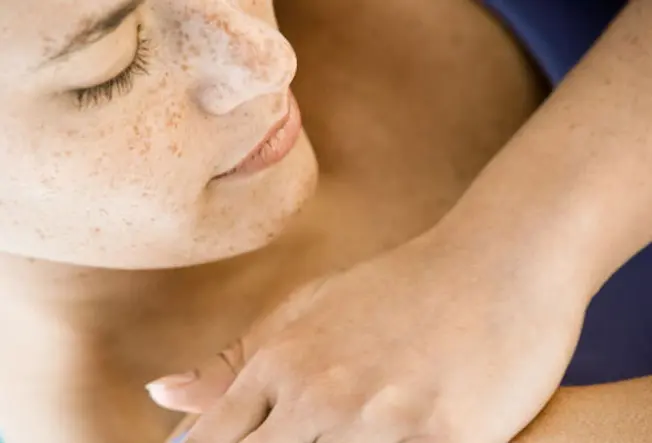
Got Skin Problems?
1 / xix
Is your pare itchy, broken out, or covered in a rash or strange spots? Pare inflammation, changes in texture or color, and spots may result from infection, a chronic skin condition, or contact with an allergen or irritant. If you lot think you accept one of these common adult pare problems, have your doctor check information technology out. Nigh are minor, but others can point something more serious.
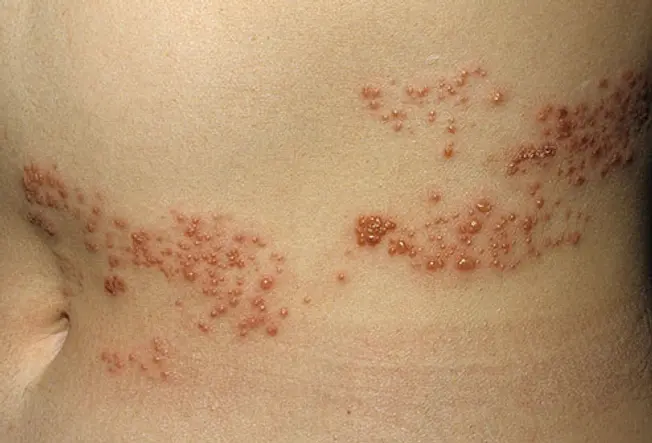
Shingles (Canker Zoster)
two / 19
A rash of raised dots that turns into painful blisters, shingles causes your skin to burn, crawling, tingle, or go very sensitive. Shingles often shows up on your body and buttocks, but can appear anywhere. An outbreak lasts about ii weeks. You'll recover, but pain, numbness, and itching might linger for months, years, or fifty-fifty the rest of your life. Treatment includes creams for your skin, antiviral drugs, steroids, and even antidepressants.It'south of import to be treated early to help prevent complications.

Hives (Urticaria)
iii / xix
Hives wait like welts and tin can itch, sting or fire. They vary in size and sometimes join together. They may announced on any part of you and last anywhere from minutes to days. Causes include extreme temperatures, infections similar strep throat, and allergies to medications, foods, and food additives. Antihistamines and skin creams can assist.
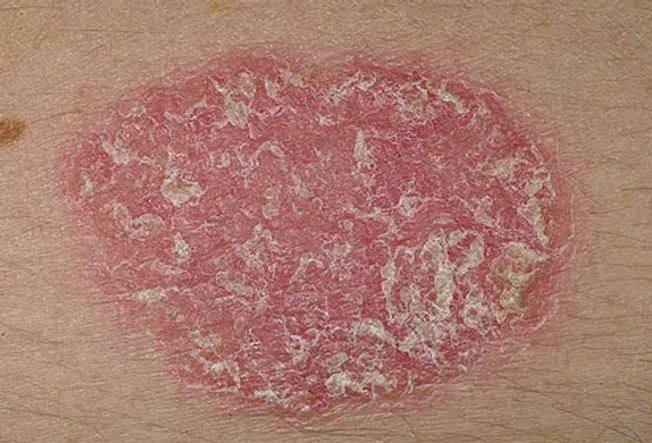
Psoriasis
4 / 19
Thick, red patches of skin covered with white or silvery scales are signs of psoriasis. Doctors know how psoriasis works -- your immune system triggers new skin cells to grow too chop-chop -- just they don't know what causes information technology. The patches typically evidence up on your scalp, elbows, knees, and lower dorsum. They can heal and come dorsum throughout your life. Treatments include creams and ointments for your skin, light therapy, and medications taken by mouth, injection, or IV.
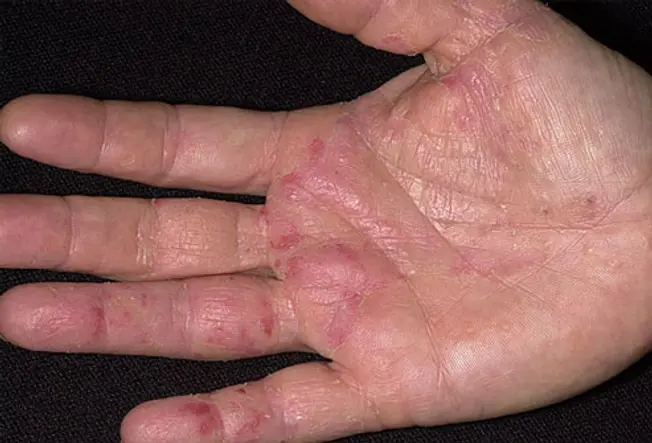
Eczema
5 / 19
Eczema is a blanket term for several non-contagious conditions that cause inflamed, ruby-red, dry, and itchy skin. Doctors aren't sure what makes eczema start in the first place, but they exercise know that stress, irritants (like soaps), allergens, and climate tin can trigger flares. In adults, it oft appears on the elbows, easily, and in peel folds. Several medications treat eczema. Some are spread over the skin, and others are taken by mouth or every bit a shot.

Rosacea
6 / 19
A trend to flush easily, followed by redness on your nose, chin, cheeks, and brow could exist rosacea. It tin get redder over time with claret vessels you can see. You may have thickened skin, bumps, and pus-filled pimples. It could even affect your eyes. Medications taken by mouth or spread on the skin are available. Doctors tin can treat broken blood vessels and blood-red or thickened skin with lasers.

Common cold Sores (Fever Blisters)
seven / nineteen
The herpes simplex virus causes pocket-sized, painful, fluid-filled blisters on your rima oris or nose. Cold sores final about ten days and easily spread from person to person. Triggers include fever, too much dominicus, stress, and hormonal changes similar periods. You tin care for common cold sores with antiviral pills or creams. Call your medico if the sores contain pus, the redness spreads, you have a fever, or if your eyes become irritated. These can exist treated with prescription pills or creams.
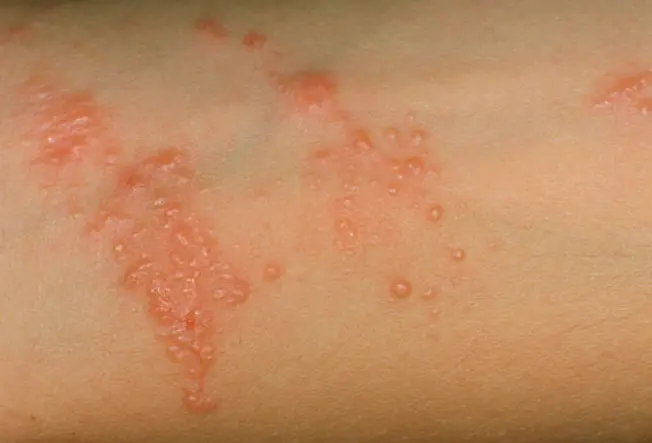
Rash From Plants
8 / nineteen
Contact with the oily coating from toxicant ivy, oak, or sumac causes a rash in many people. It begins with redness and swelling at the site, and then becomes itchy. Blisters usually show up within 12 to 72 hours after yous touch the establish. A typical rash looks like a cerise line, the result of the plant dragging across your skin. An outbreak usually lasts upwards to ii weeks. Treatment can include medicine spread on the skin or taken by mouth.
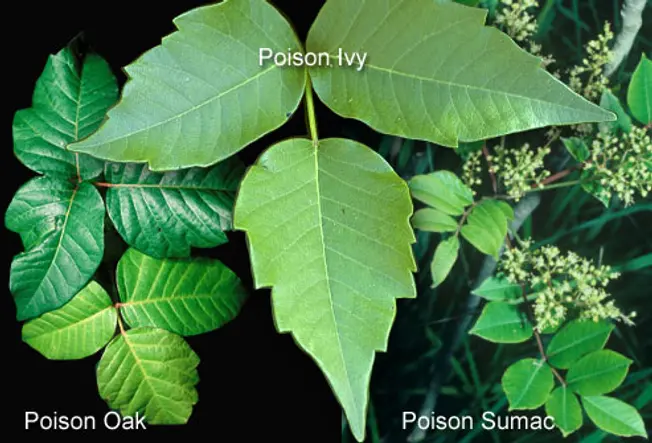
Soothe Itchy Institute Rashes
9 / 19
Prescription or over-the-counter medication can help soothe the itch. Try cool compresses and oatmeal baths, too. Your md may prescribe medication for a astringent rash and antibiotics for an infection. Acquire to spot these plants so you can avoid direct contact. In general, poisonous substance oak grows westward of the Rockies; toxicant ivy to the east.

Razor Bumps
10 / 19
Razor bumps popular upwardly later on you shave, when the abrupt edge of a closely cut hair curls back and grows into your skin. This tin cause irritation, pimples, and even scars. To minimize razor bumps, take a hot shower before y'all shave, pull the blade in the direction your hair grows, and don't stretch your skin while you lot pull the razor across information technology. E'er use a shaving cream or cream. Rinse with cold water, so apply moisturizer.

Peel Tags
11 / 19
This small flap of flesh-colored or slightly darker tissue hangs off your skin past a stalk. They're usually found on the neck, chest, back, armpits, nether the breasts, or in the groin area. Peel tags appear nearly often on women and elderly people. They aren't dangerous and unremarkably don't cause pain unless they become irritated when clothing or nearby skin rubs against them. A medico can cutting, freeze, or burn them off.
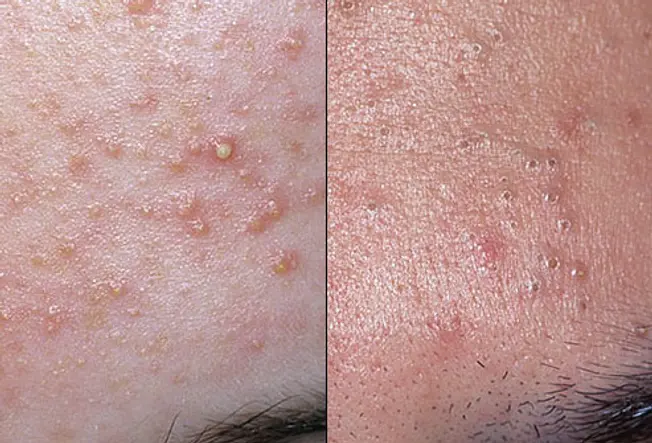
Acne
12 / 19
Acne breaks out when a pore clogged with oil and dead peel cells gets inflamed. Pores that stay open up and turn dark are called blackheads; completely blocked pores are known equally whiteheads. Bacteria and hormones trigger acne, which most often shows upwards on your confront, chest, and back. You lot can also get pus-filled pimples and cysts. To help command acne, keep oily areas make clean and don't clasp (this may cause infection and scars).
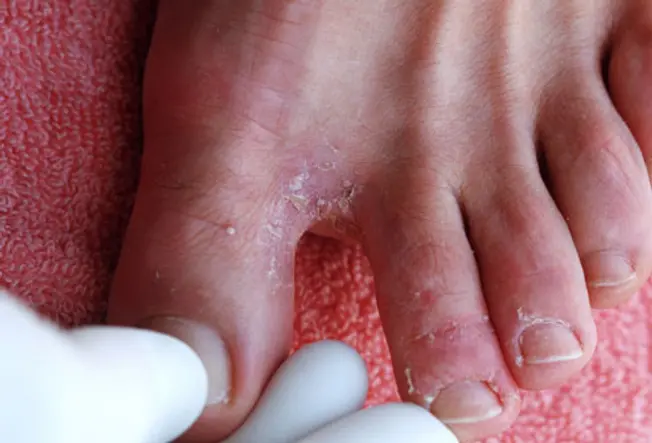
Athlete'due south Human foot
13 / 19
This fungal pare infection causes your feet to peel, turn ruby, itch, and burn. Y'all may also get blisters and sores. Athlete's human foot is contagious and passed through straight contact. To prevent information technology, don't share shoes with an infected person or walk barefoot in areas like locker rooms or near pools. Treat it with topical antifungal lotions. A md tin can prescribe medications for more severe cases. During treatment, you'll need to keep your feet and the insides of your shoes make clean and dry out.
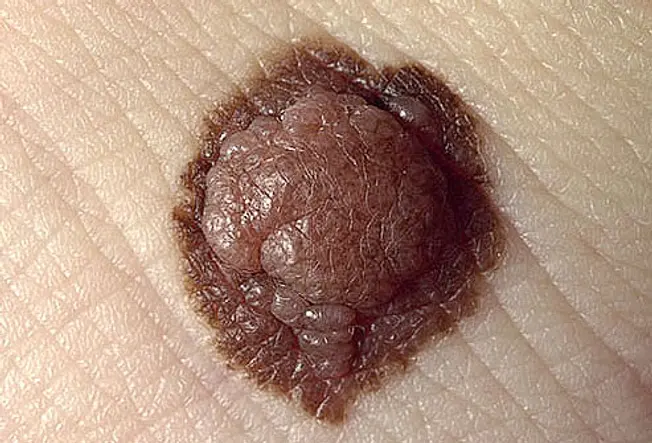
Moles
14 / 19
Moles, which are usually dark-brown or black, can be anywhere on the body. They might show up lonely or in groups and more often than not appear before age 20. Some moles change slowly over the years. They tin get from flat to raised, grow hair, or alter color. Get your moles checked in one case a twelvemonth by a dermatologist. See your doctor right away for whatever that change, have irregular borders, are an unusual or uneven color, bleed, or crawling.
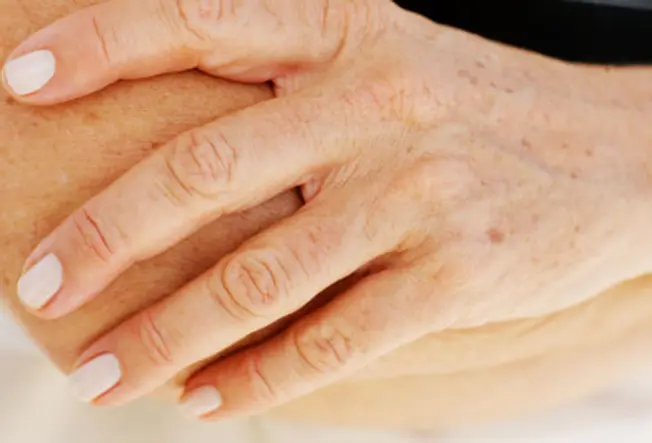
Age or Liver Spots
15 / 19
These pesky dark-brown or gray spots aren't really caused by aging, though they do get more than common as you get older. Yous get them from exposure to sunlight, which is why they tend to appear on your confront, hands, and arms. You tin can try bleach creams, acid peels, and light-based treatments to fade them. See a dermatologist to rule out serious problems like melanoma, a blazon of peel cancer.
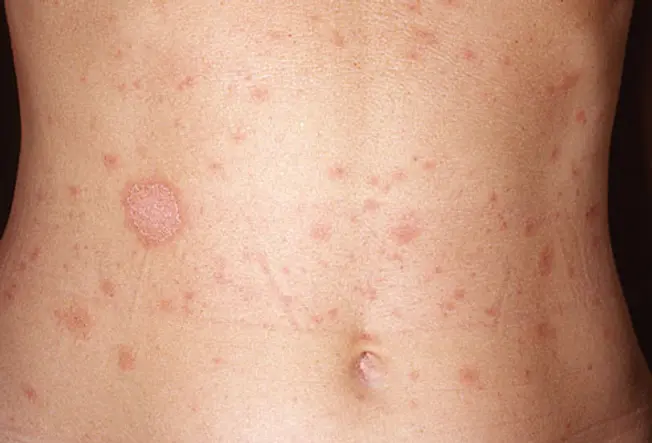
Pityriasis Rosea
16 / 19
A harmless rash, pityriasis rosea usually begins as a single scaly, pinkish patch with a raised border. Days to weeks later, information technology starts to crawling and spread. The rash may be in the shape of a Christmas tree spread across your body. Doctors don't know for sure what causes information technology, but they don't retrieve it's contagious. It often goes away in 6 to 8 weeks without handling. Pityriasis rosea most often shows up between the ages of 10 and 35.

Melasma ('Pregnancy Mask')
17 / 19
Melasma (chloasma) is tan or brown patches on your cheeks, nose, forehead, and chin. It's often called the "pregnancy mask" because information technology happens in half of all meaning women. Men can get it, also. If it doesn't become away on its ain after the babe comes, you can care for it with prescription creams, over-the-counter products, or with laser treatments. Sunlight makes it worse, so ever use a wide-spectrum SPF 30 sunscreen.

Warts
18 / nineteen
In most cases, common warts appear on the fingers or easily. They're acquired past the human being papillomavirus. Warts spread when you lot touch on something used by a person with the virus. To prevent more warts, cover them with bandages, continue them dry, and don't selection them. They're usually harmless and painless. You lot can treat them with topical medications, or a doctor can freeze or burn down them off. More advanced removal techniques include surgery, lasers, and chemicals.
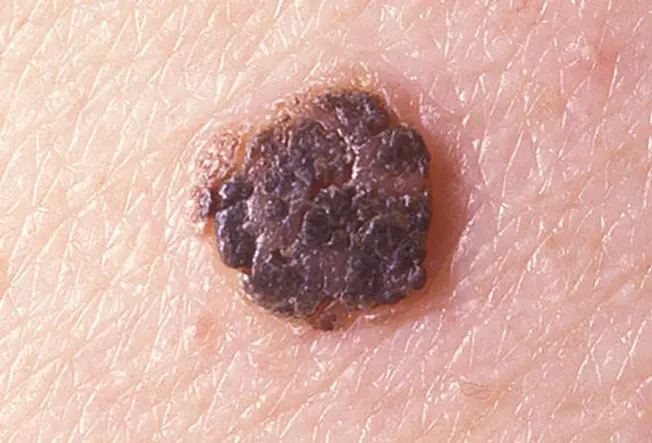
Seborrheic Keratoses
19 / 19
Seborrheic keratoses are noncancerous growths that often bear witness upwards as yous historic period. They tin announced on many areas of the skin either alone or in groups. They may be night or multicolored, and they ordinarily take a grainy surface, though they can be polish and waxy. You don't need to care for them unless they get irritated or you don't like the way they wait. They're easy to mistake for moles or skin cancer, but a dermatologist can tell the difference.
IMAGES PROVIDED BY: i) Alix Minde/Getty Images SOURCES: American Academy of Dermatology: "Hives," "Atopic Dermatitis/Eczema," "Lip and Oral fissure Care," "Poison Ivy: Signs and Symptoms," "Men's Peel Care," "Pityriasis Rosea," "Melasma," "Warts." American Academy of Allergy, Asthma & Immunology: "All About Hives (Urticaria)." Centers for Disease Control and Prevention: "Athlete'southward Foot (Tinea Pedis)." National Institute of Arthritis and Musculoskeletal and Peel Diseases: "Psoriasis." National Institute of Neurological Disorders and Stroke: "Shingles Information Page." The National Rosacea Society, "All About Rosacea." The Cleveland Clinic: "Diseases & Conditions: Moles, Freckles, Peel Tags, Benign Lentigines, and Seborrheic Keratoses." Prove Sources
2) Interactive Medical Media LLC
three) Interactive Medical Media LLC
four) Interactive Medical Media LLC
5) Interactive Medical Media LLC
6) Interactive Medical Media LLC
7) Courtesy of the CDC
viii) Bill Beatty/Visuals Unlimited
nine) Roy Morsch/Historic period Fotostock, John Sohlden/Visuals Unlimited, Ed Reschke/Peter Arnold Images
x) "Colour Atlas of Cosmetic Dermatology"; Marc R. Avram, Sandy Tsao, Zeina Tannous, Mathew M. Avram; Copyright 2007 past The McGraw-Hill Companies, Inc. All rights reserved.
11) Interactive Medical Media LLC
12) Interactive Medical Media LLC
13) Phanie / Photo Researchers, Inc
fourteen) Interactive Medical Media LLC
fifteen) Louis Play tricks / Getty Images
16) Interactive Medical Media LLC
17) Interactive Medical Media LLC
18) Interactive Medical Media LLC
xix) Interactive Medical Media LLC
Source: https://www.webmd.com/skin-problems-and-treatments/ss/slideshow-common-adult-skin-problems
0 Response to "How to Tell What Type of Rash You Have"
Post a Comment